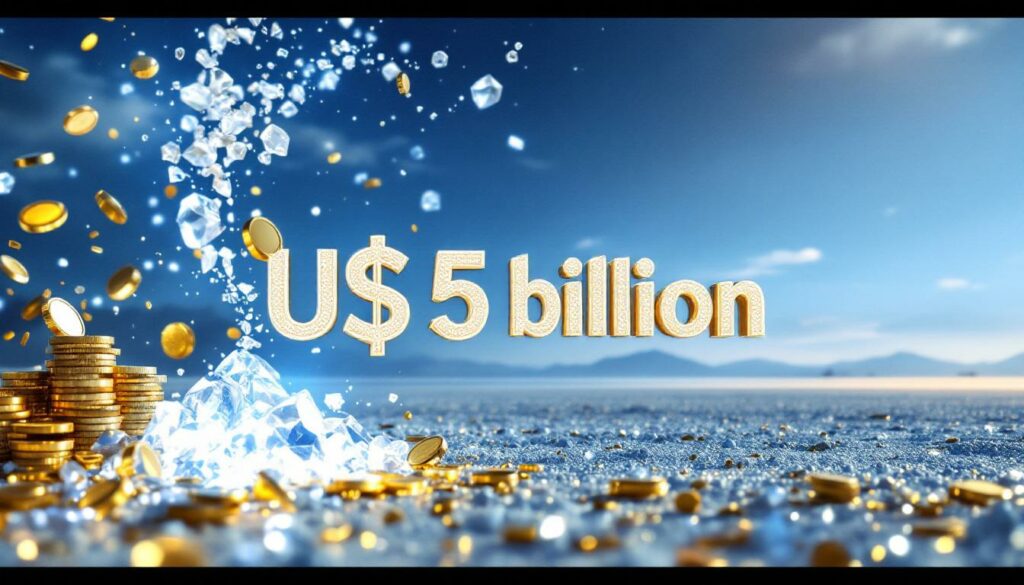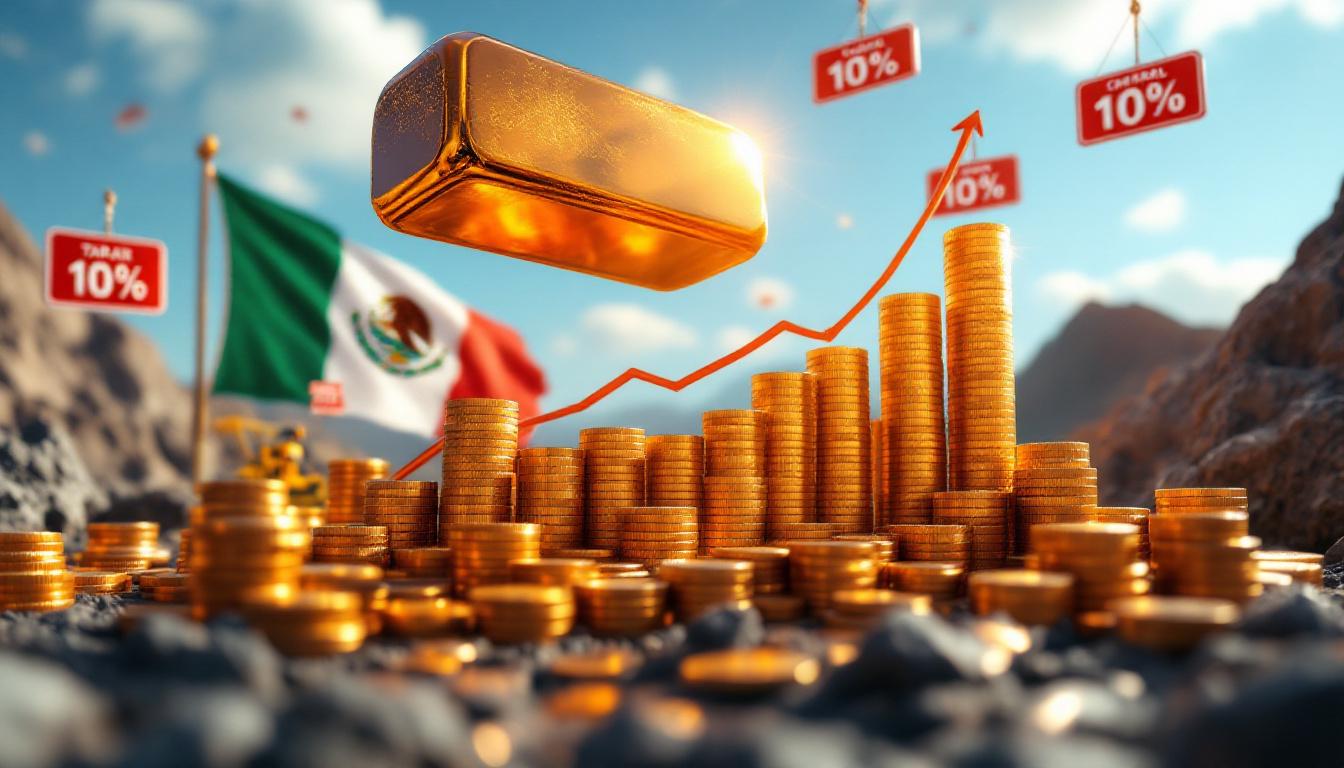What's Driving Argentina's Record Mining Export Growth?
Argentina's mining sector is poised to achieve unprecedented export values in 2025, with projections indicating figures will exceed US$5 billion for the first time in the country's history. This milestone represents the culmination of five consecutive years of export growth, despite significant production challenges in traditional mining operations.
The remarkable 14% projected annual growth for 2025 builds upon an impressive 30% year-over-year increase already recorded in the first half of the year, according to the joint report by the Argentine Chamber of Mining Companies (CAEM) and the Rosario Board of Trade (BCR).
"These figures demonstrate the resilience of Argentina's mining sector amid global economic uncertainties," notes Nadav Rajzman, CAEM's chief analyst. "The growth trajectory is particularly significant when compared to our previous export peak in 2012, which reached approximately US$2.3 billion."
This export surge comes despite ongoing production challenges in mature mines, highlighting the sector's fundamental strength and its growing strategic importance to Argentina's economy as a source of foreign currency.
How Have Mining Exports Performed in Recent Years?
Historical Context and Current Trajectory
Argentina's mining exports have demonstrated remarkable resilience over the past five years, with 2025 set to mark the fifth consecutive year of value increases. This consistent upward trend contrasts with the sector's historical volatility and represents a significant evolution from the previous export peak in 2012.
"What makes this growth particularly noteworthy is that it's occurring despite production volume challenges in traditional mining operations," explains Guido D'Angelo, senior analyst at the Rosario Board of Trade. "The sector has managed to transform these challenges into opportunities through diversification and strategic focus on critical minerals energy transition."
The current trajectory reflects a fundamental shift in Argentina's mining profile, with lithium emerging as a powerful growth driver alongside the traditional gold and silver operations that have historically dominated the country's mining exports.
First Half 2025 Performance
The first six months of 2025 have already recorded a 30% year-over-year increase in mining exports, establishing a strong foundation for the projected annual growth rate of 14%. This impressive performance amid global economic headwinds underscores the sector's fundamental strength.
According to the CAEM/BCR report, export values in the first half of 2025 reached approximately US$2.4 billion, putting the sector firmly on track to exceed the US$5 billion annual target. This performance is particularly notable given the production challenges faced by mature gold and silver operations.
"Argentina's mining sector is demonstrating extraordinary resilience in 2025, with first-half export growth of 30% year-over-year setting the stage for what will likely be a historic annual performance," notes the CAEM/BCR report. "This growth comes despite ongoing production challenges in traditional mining operations."
Which Minerals Are Driving Export Growth?
Gold and Silver: Traditional Export Pillars
Despite production volume declines since 2020, gold and silver continue to dominate Argentina's mining export basket, accounting for approximately 81% of total mining exports. The mature nature of many of Argentina's gold and silver operations presents both challenges and opportunities for the sector.
For 2025, production is projected to reach:
- Gold: Over 1,114,000 ounces
- Silver: Approximately 19.6 million ounces
These figures represent a continuation of the production challenges faced by mature mining operations, which have experienced declining output and rising operational costs over recent years.
"The declining ore grades at major gold operations like Cerro Negro in Santa Cruz province present significant challenges," explains mining geologist Dr. Marcela Cintón. "However, the exceptionally strong gold prices record highs has offset these production challenges, allowing operations to maintain profitability despite increasing costs."
Lithium: The Rising Star
The lithium sector stands as the most dynamic component of Argentina's mining industry, with 2025 production expected to reach approximately 130,000 tonnes LCE (Lithium Carbonate Equivalent). This represents a remarkable 75% year-over-year increase compared to 2024 volumes.
If current projections hold, Argentina's 2025 lithium production will be:
- 185% higher than 2023 levels
- Triple the average production recorded between 2015-2022
Argentina's lithium production is primarily concentrated in the "Lithium Triangle" that spans portions of Argentina, Bolivia, and Chile. Within Argentina, the provinces of Jujuy, Salta, and Catamarca host the most significant lithium operations, with production predominantly extracted from salt flat brines.
The lithium complex in Argentina is predominantly composed of:
- Carbonato de litio (lithium carbonate): Over 90% of production
- Cloruro de litio (lithium chloride) and hidróxido de litio (lithium hydroxide): Comprising the remainder
"Argentina's lithium sector is experiencing an unprecedented boom driven by global demand for battery materials," notes Tomás Herrero, director of the Argentine Institute of Mining Analysis. "The extraction process from brine operations in Argentina generally involves evaporation ponds followed by processing to produce lithium carbonate, which is then either exported directly or further refined into lithium hydroxide for premium battery applications."
Furthermore, the Argentina lithium brine insights reveal that the country has some of the most cost-effective production methods globally, providing a competitive advantage in international markets.
What Price Assumptions Support Export Projections?
The record histórico en exportaciones mineras en Argentina projections are based on the following price assumptions:
| Mineral | Projected 2025 Price | Change vs. 2023 Average |
|---|---|---|
| Gold | US$3,300 per ounce | +35% |
| Silver | US$32 per ounce | +28% |
| Lithium Carbonate | US$8,500 per tonne LCE | -52% |
These price estimates align with references from the World Bank, CME Group, and data compiled by Argentina's National Mining Secretariat. The export calculations also assume achievement of approximately 85% of projected production volumes for these key minerals.
"The 85% achievement factor reflects a conservative approach to projections," explains Guido D'Angelo. "It accounts for potential operational disruptions, weather events, or logistical challenges that could impact actual production."
It's worth noting that while gold and silver prices have strengthened significantly, lithium prices have moderated considerably from their 2022-2023 peaks. Despite this price normalization, the substantial production volume growth in lithium is expected to more than offset the impact of lower prices.
"What's particularly interesting about the current projections is the contrasting price environments for precious metals versus lithium," notes the CAEM/BCR report. "Gold and silver are benefiting from global economic uncertainties and inflation concerns, while lithium prices have moderated as supply expansion has caught up with demand growth."
According to recent gold prices analysis, the precious metal's strength is likely to continue through 2025, providing crucial support for Argentina's mining exports.
What Challenges Does the Mining Sector Face?
Production Volume Decline in Traditional Mines
A significant concern highlighted by industry analysts is the ongoing decline in production volumes at Argentina's major gold and silver operations since 2020. Many of these mines have been operational for decades, resulting in:
- Gradually decreasing ore grades
- Rising operational costs
- Increased vulnerability to potential price downturns
The maturity of these operations presents a dual challenge: maintaining profitable production while navigating the natural decline in ore quality that occurs as mines age. While current international price levels have prevented mine closures, the situation leaves operations in a precarious position should global prices decline significantly.
"The challenge of declining ore grades is a natural part of a mine's lifecycle," explains Dr. Marcela Cintón. "At several major gold operations in Santa Cruz province, companies are having to process more material to extract the same amount of gold, which increases costs and environmental footprint."
Need for New Project Development
The CAEM/BCR report emphasizes the importance of advancing exploration and construction of new mining projects, particularly in copper, to diversify Argentina's mining export portfolio. Expanding beyond the current concentration on gold, silver, and lithium would provide greater resilience against commodity-specific market fluctuations.
Several significant copper projects are in various stages of development, including:
- Josemaría (San Juan province): Advanced-stage development with potential production by 2027
- Taca Taca (Salta province): Moving through permitting stages
- El Pachón (San Juan province): Undergoing feasibility studies
"Copper represents the next frontier for Argentina's mining sector," notes Tomás Herrero. "These projects have the potential to transform Argentina into a significant copper producer by the end of the decade, providing a valuable diversification from the current focus on gold, silver, and lithium."
Regulatory and Social License Challenges
Beyond the technical challenges, Argentina's mining sector continues to navigate a complex regulatory environment and social license issues. While the national government has implemented the RIGI (Régimen de Incentivo a las Grandes Inversiones) to attract investment, implementation at the provincial level has been uneven.
"The rejection of Chinese lithium producer Ganfeng's RIGI application in Salta province highlights the ongoing regulatory uncertainties," explains legal mining permitting insights specialist Dr. Marina Salvatierra. "While the national framework seeks to promote investment, provincial authorities maintain significant autonomy in implementation."
Water usage remains a particularly sensitive issue in many mining regions, with concerns about impacts on local agriculture and communities. Companies increasingly recognize that securing and maintaining social license requires comprehensive community engagement and environmental stewardship.
How Are Industry Organizations Supporting Growth?
The joint report by the Argentine Chamber of Mining Companies (CAEM) and the Rosario Board of Trade (BCR) represents a collaborative effort to provide reliable data for both public and private decision-making. This partnership consolidates projections from the country's leading mining companies to create a comprehensive view of the sector's trajectory.
"Our goal with this collaboration is to bring transparency and data-driven analysis to discussions about Argentina's mining sector," explains CAEM president Marita Ahumada. "For too long, mining has been subject to political polarization rather than objective analysis of its economic and development potential."
The initiative aims to generate useful tools for strategic planning in a sector considered vital for Argentina's economic development, particularly in the context of global energy transition demands. By collecting and analyzing data from member companies representing over 90% of Argentina's mining production, the organizations provide a uniquely comprehensive view of the sector.
CAEM has also expanded its international collaboration efforts, partnering with organizations like the London Metal Exchange (LME) to provide advanced training opportunities for Argentine mining professionals. These initiatives focus on developing expertise in areas such as commodity trading, price risk management, and international market access.
What's the Outlook for Argentina's Mining Sector?
Short-Term Projections
With 2025 shaping up to be a record year for mining exports, the immediate outlook appears positive, driven primarily by exceptional growth in lithium production and favorable commodity prices. The projected US$5 billion in exports would represent a significant milestone for the industry.
"The short-term outlook is particularly strong for lithium, with several expansion projects set to come online in 2025-2026," notes lithium market analyst Lucía Pérez. "Operations like Cauchari-Olaroz in Jujuy and Sal de Vida in Catamarca will add significant new production capacity, further cementing Argentina's position as a top-tier lithium producer."
For gold and silver operations, the outlook hinges more heavily on price stability, given the production challenges faced by mature operations. The current strong price environment provides a buffer against declining ore grades and rising costs, but operators remain vigilant about potential market volatility.
According to a recent report by Ámbito, the récord histórico en exportaciones mineras en Argentina is also being driven by increased international investment in the sector.
Medium and Long-Term Potential
Looking beyond 2025, the sector's focus is on:
- Developing copper projects to add another major export complex
- Continuing expansion of lithium operations
- Addressing production challenges at mature gold and silver mines
- Positioning Argentina as a key supplier of critical minerals for the global energy transition
"The medium-term outlook will be significantly influenced by how successfully Argentina can advance its copper project pipeline," explains Tomás Herrero. "If projects like Josemaría and Taca Taca can progress to production by 2027-2028, we could see Argentina's mining exports approach the US$8-10 billion range by 2030."
For lithium, the outlook remains strong despite price moderation from 2022-2023 peaks. Analysts project that Argentina could reach production capacity of 200,000-250,000 tonnes LCE by 2030, potentially positioning the country as the world's second-largest lithium producer.
"Argentina's lithium sector benefits from several competitive advantages, including relatively low production costs from brine operations and significant untapped resources," notes the CAEM/BCR report. "The key challenge will be accelerating project development timelines to capitalize on the current window of opportunity in the global energy transition."
How Does Mining Fit into Argentina's Economic Strategy?
The mining sector's growing export contribution aligns with Argentina's broader economic objectives of increasing foreign currency earnings and diversifying export offerings. As traditional mining operations face production challenges, the emergence of lithium as a growth driver demonstrates the sector's ability to evolve with changing global demands.
In 2025, mining exports are projected to represent approximately 6% of Argentina's total exports, up from roughly 4% in 2020. This increasing contribution comes at a critical time for Argentina's economy, which continues to face significant macroeconomic challenges including inflation and foreign exchange pressures.
"Mining represents one of Argentina's most promising avenues for sustainable export growth," explains economist Dr. Fernando Miguez. "Unlike some traditional exports, mining products generally face strong and growing global demand, particularly for materials like lithium that are essential to the energy transition."
The Milei administration has identified mining as a priority sector for economic development, implementing regulatory reforms aimed at attracting investment and streamlining permitting processes. The RIGI framework, despite implementation challenges, represents an attempt to position Argentina as an attractive destination for mining investment.
The industry's focus on minerals critical to the energy transition also positions Argentina to benefit from increasing global demand for these resources, potentially creating a sustainable growth path for the coming decades. As developed economies implement decarbonization strategies, demand for lithium, copper, and other critical minerals is projected to grow substantially.
As the Argentine Association of Mining Industrial Chambers has reported, the récord histórico en exportaciones mineras en Argentina is creating thousands of new jobs in provinces that have historically struggled economically.
"Argentina has the potential to become a key supplier in the global critical minerals supply chain," notes Dr. Marina Salvatierra. "However, realizing this potential will require addressing regulatory uncertainties, improving infrastructure, and maintaining a competitive investment framework."
Disclaimer: This article contains projections and forecasts based on current trends and market conditions. Actual results may differ materially from these projections due to various factors including but not limited to: changes in commodity prices, regulatory developments, operational challenges, and macroeconomic conditions. Readers should not make investment decisions solely based on the information contained in this article.
Ready to Capitalise on the Next Major Mineral Discovery?
Discover how significant ASX mineral announcements can lead to exceptional returns with Discovery Alert's proprietary Discovery IQ model, which transforms complex mining data into actionable investment insights. Explore historic examples of transformative discoveries by visiting the Discovery Alert discoveries page and begin your 30-day free trial today.




